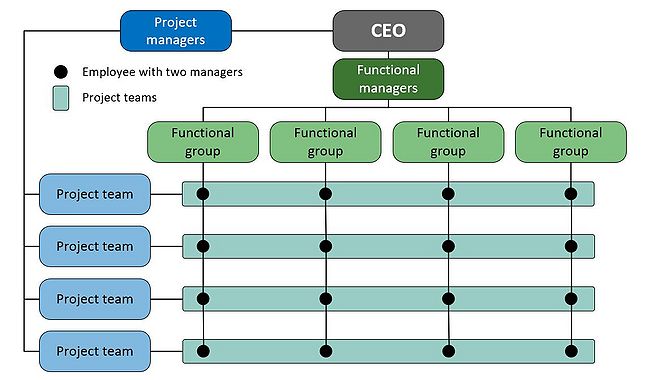Managing projects in a functional organization
Contents |
Abstract
Functional organisations, where the employees are grouped based on skills and job type, are useful to increase knowledge sharing within the groups. I.e. a functional group with programmers allows the programmers to help and learn from one another during working hours. This results in more specialized groups with self-increasing skills, though limiting the connection between people with different skill sets. Divisional organisations, where the employees are divided into groups based on location, product or market instead, have a broad variety of people with different skills in each group. This allows for better interactions among the different skill sets during working hours but takes away the knowledge sharing with like-minded people. [1]
Projects are generally complex and require people with various skills to be done. Thus, the divisional organisation structure seems like the better fit for projects, as the need for inter-group communication is far less crucial. In a functional organization, all groups involved with the project have to be in close communication with one another in order to maintain a common direction for the project. This is where the project manager becomes important.
This article highlights the common challenges that a project manager must deal with when doing projects in a functional organization.
Introduction
Pending... When designing an organization, several initial design decisions have to be made like vision, strategy
275
Organizational structure

The term "organizational structure" covers the formal system of task and job reporting relationships between employees and how the organizations ressources should be spent to obtain its goals. The structure is determined by managers, typically based on the four factors described by the contingency theory; organizational environment, strategy, technology and human resources. This process is described by the term "organizational design" which includes job design (division of the tasks required to run the organization into jobs) and design of the organizational structure.
Overall, there are two distinct types of organizational structures; divisional and functional. However, large and complex organisations can create matrix structures which combine divisional and structural elements. The final design is determined so that it maximizes the efficiency and effectiveness of the organization.
Functional structure
Grouping the jobs based on skill requirements, so that employees with resembling skill sets work together, is the idea of the functional structure. A functional organization is composed of all the departments that are required for the organization to deliver its products, being goods or services. I.e. a car manufacturing company could be composed of a marketing department, a procurement department, a production department and an engineering department. This structure is broadly applied, both because it is easy for functional managers to evaluate the performance of the employees in their respective departments but also because each department can be more specialized due to knowledge-sharing among the employees. Thus, the performance of all departments will be higher in a functional structure. Tasks that are completed within the departments might often share common attributes and will be completed faster due to increased collaboration among like-minded employees. From an ideal point of view, the functional structure provides the highest performing departments.
Divisional structure
However, when organizations grow too large and begins to produce a wider range of goods or services and deal with a larger variety of customers...
Project management in functional organizations
Pending...